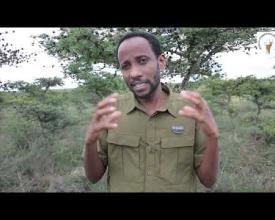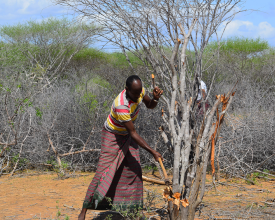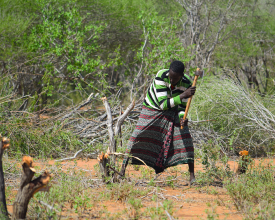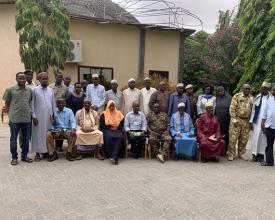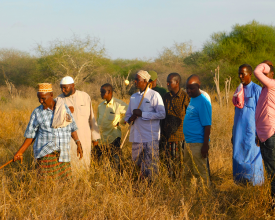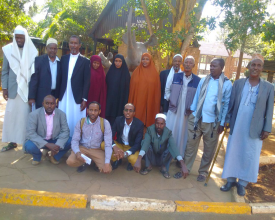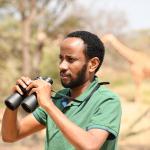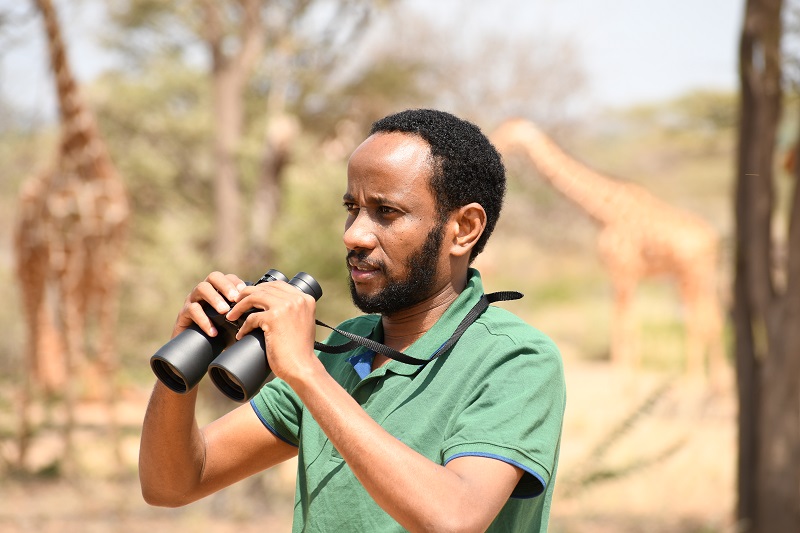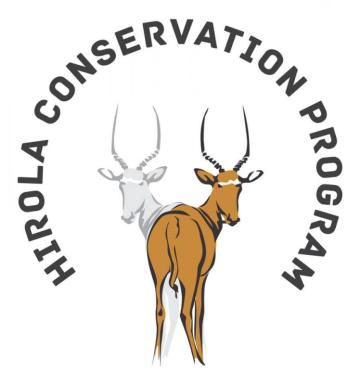
Restoring grasslands to enhance the recovery of the critically endangered hirola antelope and improve local livelihoods.
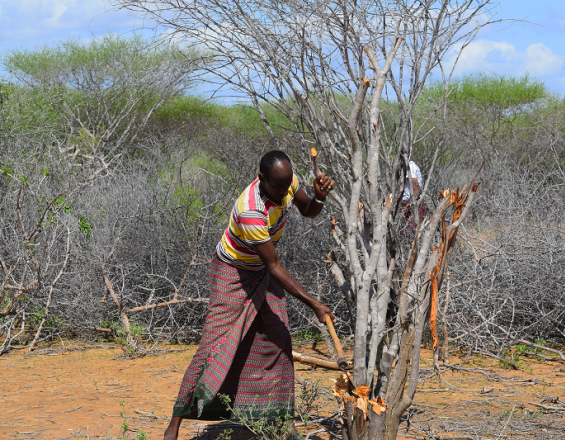
Our solution saves the critically endangered hirola antelope from extinction while also improving local livelihoods using Nature-based Solutions (NbS). We are improving hirola rangeland quality by manually clearing invasive trees and planting native grasses both in hirola core areas and areas earmarked for future reintroductions. This is an on-going 10-year project to restore 10000 acres of hirola habitat which is expected to bolster hirola numbers by 1000%. Manual removal of these invasive trees at scales of thousands of hectares results in vast acres of unwanted biomass. We therefore introduced NbS that uses and commercializes the invasive trees and restored sites. These includes production of hirola briquettes from the invasive trees and harvesting and sale of grass seeds. This enhances the well-being of the locals especially during the current pandemic.
Contexte
Challenges addressed
The hirola antelope is one of the few species that is described as a refugee species. This is because over the last 4 decades, the hirola experienced a 95% population decline driven by shrinking grasslands (~75% decline). The optimal habitat for hirola was largely grasslands, however, long-term satellite imagery analysis revealed a nearly 300% increase in tree cover between 1985 and 2012 within the hirola’s range. The increase in tree cover poses one of the greatest threats to the survival of hirola through food limitation. Therefore, if these trends are not reversed, the recovery of hirola will become insurmountable. Reduced grasslands have also affected livestock production threatening local livelihoods in eastern Kenya. COVID-19 has aggravated the situation through restrictions and lockdowns that have further affected local livelihoods through reduced local tourism revenues and closure of livestock markets which were the major source of livelihoods.
Emplacement
Traiter
Summary of the process
Our community based approach helps us interact, understand the locals and gain their support in our restoration activities. In collaboration with the locals, and in community lands (Bura East Community Conservancy) we clear the invasive the invasive trees and plant native grasses. We then introduce alternative livelihoods on the restored sites and as they benefit from these sites, they manage them sustainably. We facilitate the to produce hirola briquettes from the cut invasive trees and harvest and sell native grass seeds from the grasslands. We do this through education and awareness, capacity building and provision of the necessary production equipment through our international partners.
Building Blocks
Community-based Approach
Historical conservation efforts within our region was probihitive because of the insecurity within the horn of Africa, remoteness of the region and language barriers. However, our community based approach that involved the locals in all the conservation activities eventually led to effectively bridging the gap between the local communities and conservation agencies in an otherwise historically prohibitive region due to cultural barriers between the Somalis and other ethnic groups.
Enabling factors
We engage the local communities through education, awareness & sustainable NbS that improve their ways of life. Through these ways, we have successfully changed the local attitude towards wildlife and habitat conservation and gained their support. We gained the communities’ trust & support by providing employment and also facilitating local youths to study wildlife related courses at the tertiary level. In addition, the local clans typically ascribe to hirola as a near-mythical status, & therefore have a cultural incentive to support our efforts.
Lesson learned
The key lesson learnt is to always respect the local cultures and their local systems by always holding consultative sessions with local elders. In the local Somali culture, elders are representatives of their communities and are tasked with safeguarding all aspects of the community including politics, cultural, economic, religious and social welfares. The communities lend their trust to the elders and give them the authority to manage the communities’ resources including communal lands. In this regard, it is important to always consult with the elders who command authority and are representatives of the communities.
Alternative livelihoods
Establishing alternative livelihoods for the locals was as a result of the need for effective and sustainable management of the restored sites long after the life of the project. Once the local communities benefit from the restored grasslands, then they would manage the sites well and with the knowledge and skills imparted on them, they would continue increasing grasslands relatve to tree cover. In addition, the alternative livelihoods perfectly complemented the hirola rangelands restoration efforts. It was an excellent win-win situation. The locals produce hirola briquettes (certified high-heat, low-emission, compacted logs for use as cooking fuel) from the invasive trees and harvest native grass seeds from the restored sites for sale.
Enabling factors
A good understanding of the needs of the local communities; they are amongst the most marginalized in Kenya. Most of them are pastoralists who wholly depend on livestock. Recurring drought conditions impoverishes their livestock & threatens their livelihoods. These communities need new employment opportunities that make them resilient to drought conditions. One of the major reasons that the locals support our conservation activities is that they make a sustainable living from the restored sites i.e., monetary incentive.
Lesson learned
Frequent capacity building is vital so as to impart basic business skills that help in sustaining the enterprises in the long-term.
Impacts
To the extent possible, we are most interested in curtailing the continued decline of hirola in ways that are compatible with livestock production by local communities. Livestock will have sufficient forage and improved habitat translating to increased livestock production and increased income benefitting the indigenous communities who primarily depend on livestock production. Increased pasture and improved habitat for livestock, hirola and other wildlife will reduce human-wildlife conflicts and greatly contribute to their coexistence. Our project will employ locals as range restoration technicians and train them on best restoration practices and build their capacities in related activities including livestock husbandry and wildlife conservation which will go a long way in ensuring project sustainability as the locals will have the necessary capacity of ensuring continuity. Apart from local involvement in tree removal, reseeding and other conservation activities, our project will also result in well informed and sensitized local youth and women groups as we will continually engage them on the value of conservation, and potential alternative livelihoods to mitigate the impacts of habitat degradation. Our establishment of nature-based income generating activities for the communities will increase their sources of income and improve local livelihoods.
Beneficiaries
Hirola, other wildlife grazers, local women & youth groups (~2000 individuals), global conservation community (include conservation NGOs, universities & philanthropists), Garissa County (Kenya Government Agency) & Bura East Conservancy (Non-profit)
Sustainable Development Goals
Story
Historically, conservation efforts in East Africa have been characterized by westerners associated with flagship species. Despite their major contributions to conservation, an unanticipated consequence of their efforts is that “conservation” has traditionally been regarded by locals as the exclusive purview of whites.
I have changed that and through Hirola Conservation Programme, I have implemented multiple strategies to curb hirola declines while improving local livelihoods. Over the past 50 years, we have witnessed the transformation of open grasslands to unproductive, closed-canopy woodlands. Such tree encroachment has been detrimental to hirola and pastoral livelihoods. By the time the international conservation community was aware of the hirola’s plight, their numbers already were precariously low, the outcome of an unfortunate succession of events that unfolded over a half-century.
By combining a 30-year record of changes in tree cover (from satellite imagery) and meticulous demographic modeling, I demonstrated that hirola populations were suppressed because of loss of grasslands. Further, grassland restoration was imminently feasible over vast expanses, largely because local Somalis were enthusiastically supportive. Indeed, Somalis grant hirola a near-mythical status, and its presence is (correctly) equated with prime pastures for cattle.
My efforts were consequently targeted toward grassland restoration through tree clearing and native grass seeding. The clearing of trees has provided locals with a sustainable, environmentally friendly source of income in the form of low-emission briquettes (for cooking fuel), and sale of native grass seeds. Too often, local livelihoods and conservation outside protected are viewed as a mutually exclusive zero-sum: when one benefits, the other must suffer. In contrast, and through the creation of alternative livelihoods, my efforts have resulted in a rare ‘win-win’ by which conservationists and local communities reinforce each other.
I have invested in Somali communities, and Somali communities have invested in hirola.

